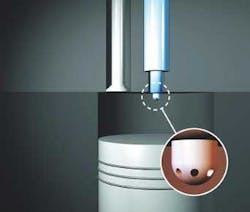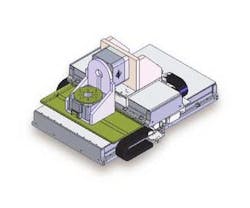High-performance motion maximizes fuel injector nozzle machining
The continuously increasing desire for higher performance automobiles drives requirements for industrial automation and, more specifically, motion control. High performance does not just mean faster or more horsepower, but also safer vehicles, better gas mileage, and aesthetic designs. These motion control automation challenges affect parts manufacturing for fuel injection systems, transmissions, assembly processes, and every other major component in a modern automobile. While Aerotech Inc. (Pittsburgh, PA) has significant experience in many automotive motion control automation challenges, here we focus on the state of the art in manufacturing fuel injector nozzles.
Production challenges
The goals of higher horsepower and better fuel efficiency drive improvements in the elements that convert fuel into power. Horsepower and fuel efficiency are greatly impacted by the fuel injection system and the exact control over the flow rate and dispersion of fuel through the fuel injector into the combustion chamber. One area that has been studied in detail is the design of injector nozzles, their spray pattern, and the subsequent fuel-air mixing that takes place in the combustion chamber. While many elements can considerably affect the final efficiency of the fuel injection system, precise machining of injector nozzle holes and other nozzle features is critical to a good overall result.
As an example, let's examine the typical fuel injector nozzle hole. Basically, the hole is designed to evenly spray fuel into the combustion chamber to maximize the power output of the combustion process. The hole volume, concentricity, taper, and its location on the nozzle are all important parameters that create a high-performance fuel injector that promotes maximum fuel-air mixing and, hence, maximum fuel combustion, efficiency, and power. The design may require that the holes have a reverse taper and vary in size (depending on application) from 50 to 100 µm on the small side, to from 100 to 200 µm on the large side. The holes are placed around the tip of the spherical nozzle at some equidistant angle. The accuracies required in the positioning, size, taper, and angle often are less than 5 microns of error in any dimension.
Laser cutting versus EDM
A variety of processes can be used to machine the holes, the two most common being laser cutting and electrical discharge machining (EDM). Each of these requires high-precision motion control platforms to accomplish the machining task. In either process, one may choose to move the nozzle, move the cutting piece, or move both, with the motion control platform/method chosen depending upon the specifics of the process. In laser machining it is common to use a trepanning head and use the motion system to appropriately position the nozzle. A second method would be to keep the laser stationary where a typical motion platform configuration is a four-axis system (two linear and two rotary axes), with the motion of all axes synchronized to make the appropriate cut. It is important that the alignment of the linear and rotary axes and the straightness and flatness specifications be less than several microns per mm.
Another design consideration is to ensure that mechanical errors that cannot be removed or calibrated out of the system do not result in increased volume of the hole, but only symmetric irregularities that maintain the most consistent flow rate. The trajectory generation of the circles (made by the X-Y pair) must be of high fidelity and the bandwidth of the servo loops mus be sufficiently high so that the dynamic following errors of the X-Y stages are minimized. To achieve the necessary requirements, the controller must be able to utilize 2D and in some cases 3D calibration files to compensate for the alignment error of the mechanics. High precision alignment with dynamic calibration compensation, high fidelity trajectory generation, and high bandwidth servo systems results in residual positioning errors that meet the requirements for high-performance machining of fuel injector nozzle holes.
3D model of a multi-axis system used for fuel injector laser machining.
For many years, Aerotech has manufactured motion platforms to cut fuel injector features. The key requirements mentioned drive design of both the mechanics and the controller of these platforms. For instance, to ensure the synchronization of multiple axes the trajectory generation is done centrally, and to meet the performance of the individual axis the servo loops are closed locally. This distributed architecture provides maximum computing power and flexibility for such applications. A second key design requirement is the ability to coordinate the laser with the motion platform. Aerotech does this through a multi-axis, hardware-based Position Synchronized Output (PSO) feature that has position error measured in nanometers. This output synchronizes the dynamic position of the motion platform with the laser system, signaling when to begin and end the cut, and to regulate the power based on velocity.
The EDM process has similar concerns to the laser process in regard to keeping the part stationary or moving the part during production, with the added complexity of integrating control of the EDM process with that of the motion. For instance, it is common in EDM to move the electrode away from the part if poor processing conditions are met, and then to re-approach the point being machined. The motion controller must be able to synchronize with the EDM process controller to provide reverse-path retrace and therefore return along the same path to the point being machined. Obviously, this requires an intimate integration of the EDM process and motion controllers.
The requirement for intimate integration with the process controller has led Aerotech to an open architecture that permits high bandwidth interfaces to the process controller, thus giving the machine builder more flexibility to innovate on the process control. Aerotech goes beyond commonly used path reversal on a block basis to provide path reversal during a block (intra-block path reversal), which provides the EDM process with new possibilities for higher precision control.
Conclusion
The desire for fuel efficiency and horsepower directly impacts fuel injector design and requires accurate injector features. These requirements dictate the specifications of the laser and EDM systems that machine the features. The higher performance demands on the laser and EDM are driving innovations in both machining processes and motion control. Z
Joseph A. ÏProfeta III is director of product marketing, automation control systems, Aerotech Inc. Visit www.aerotech.com.


